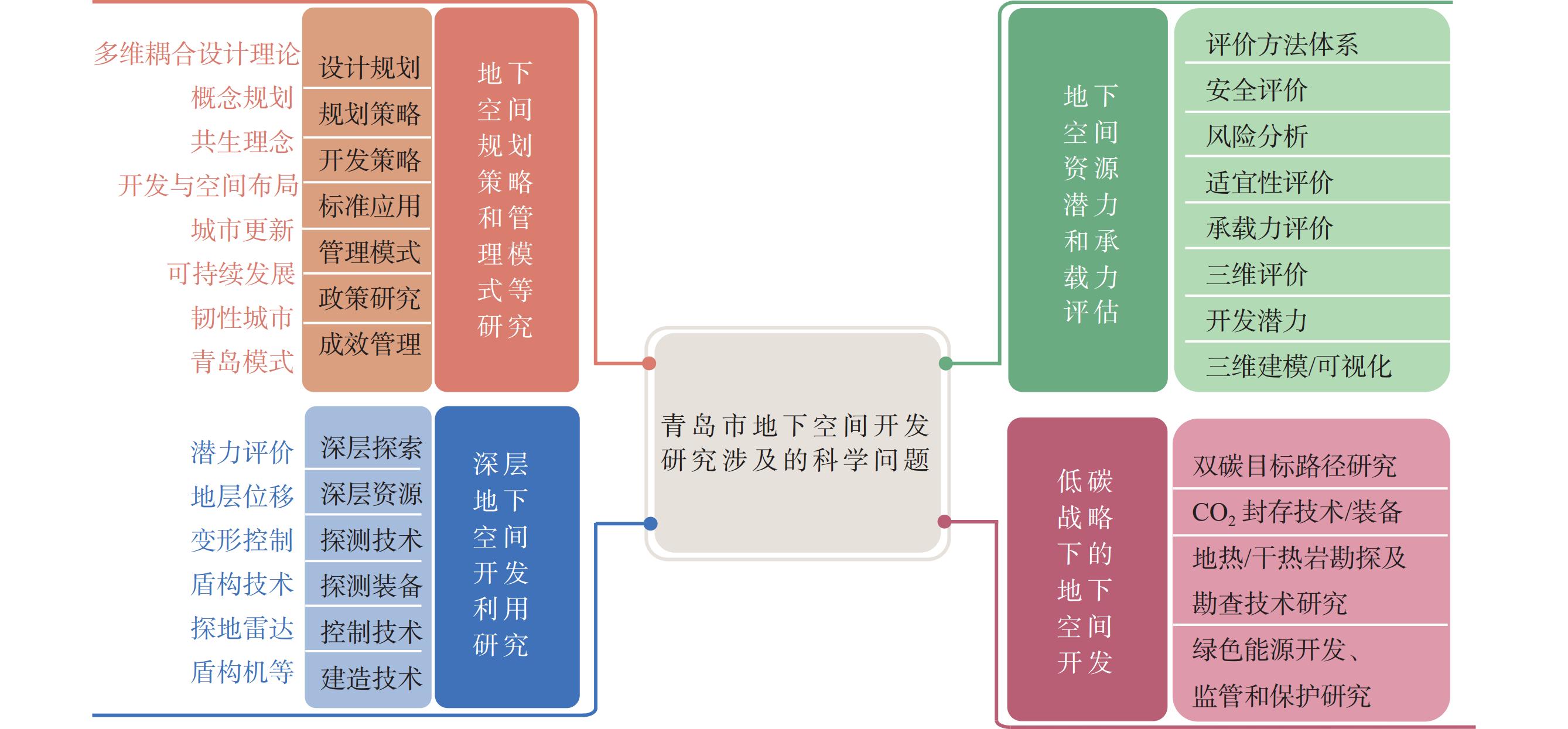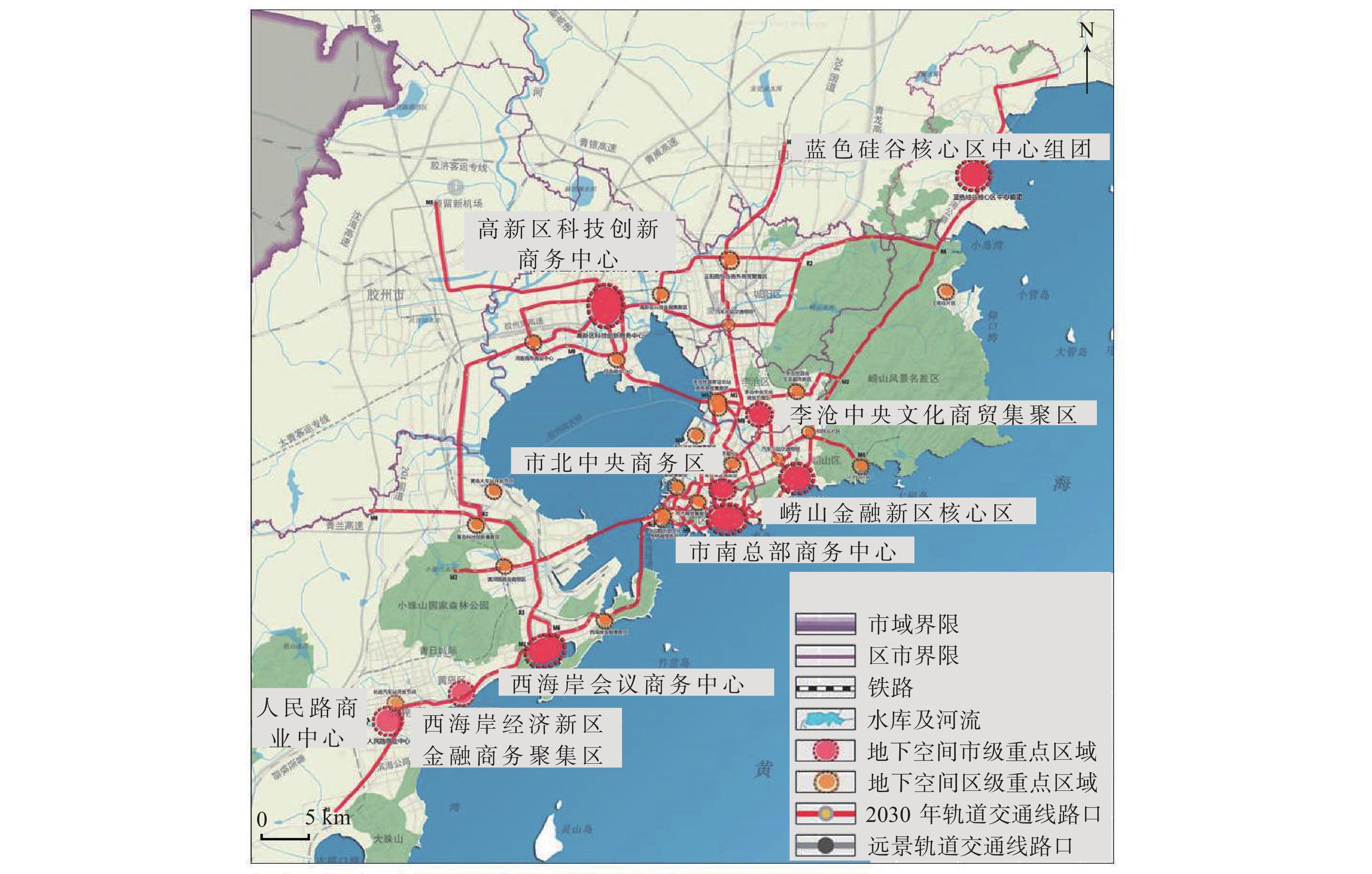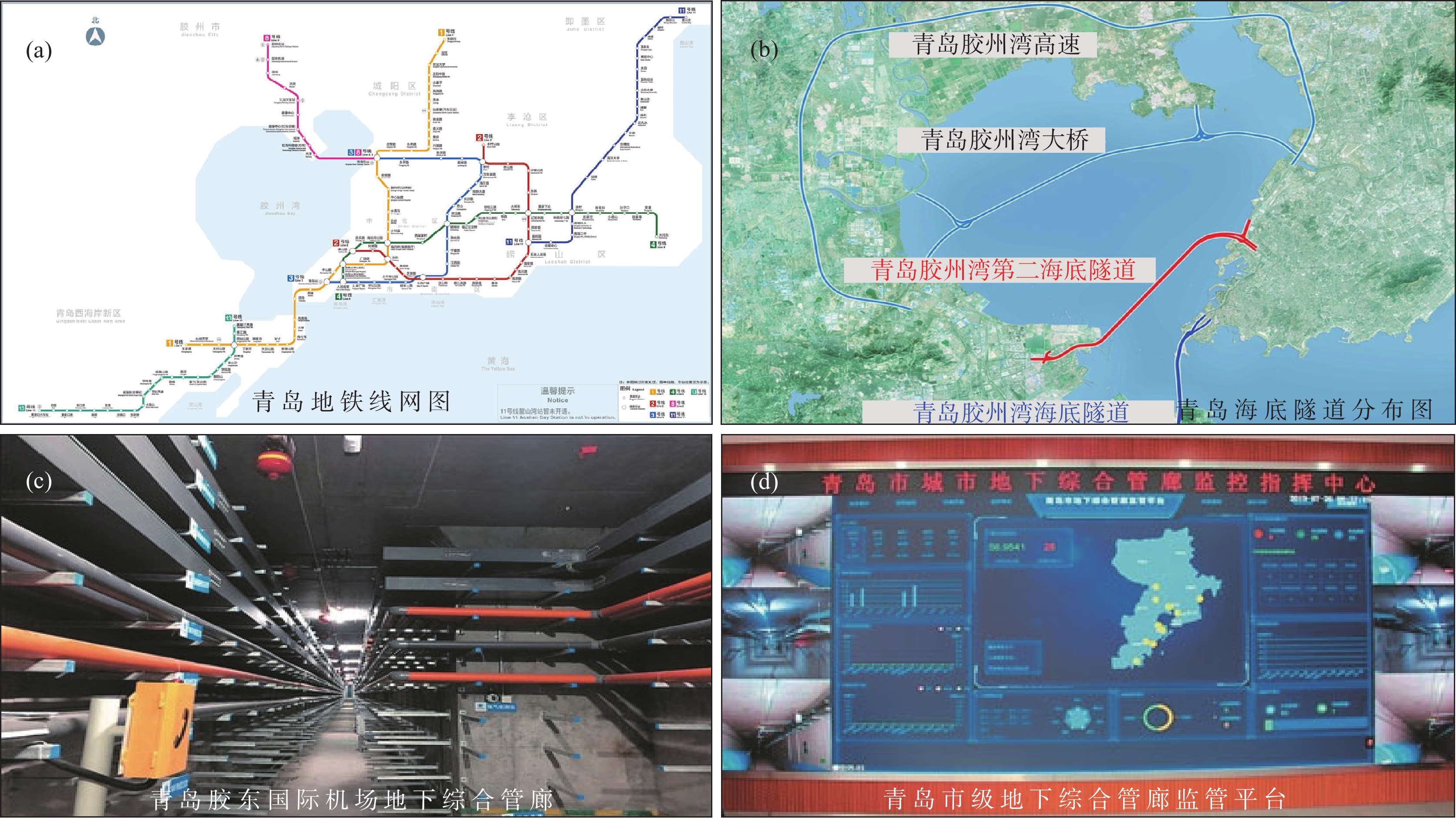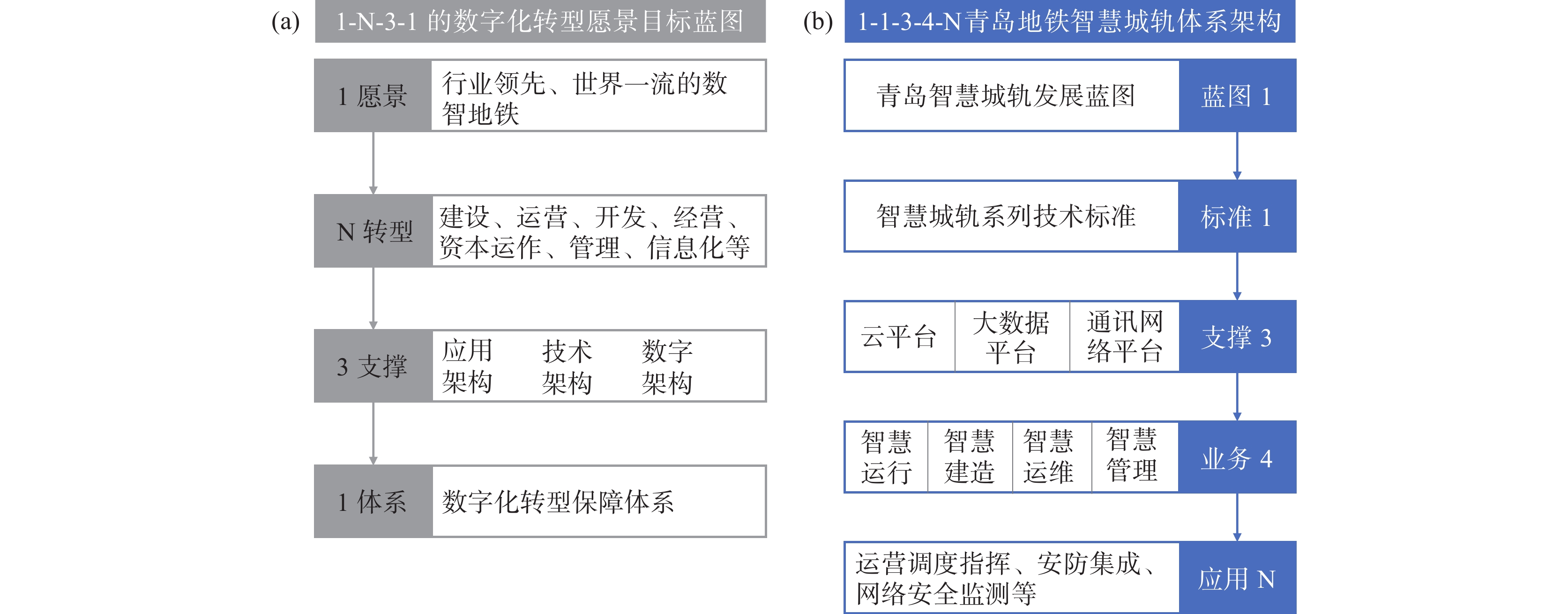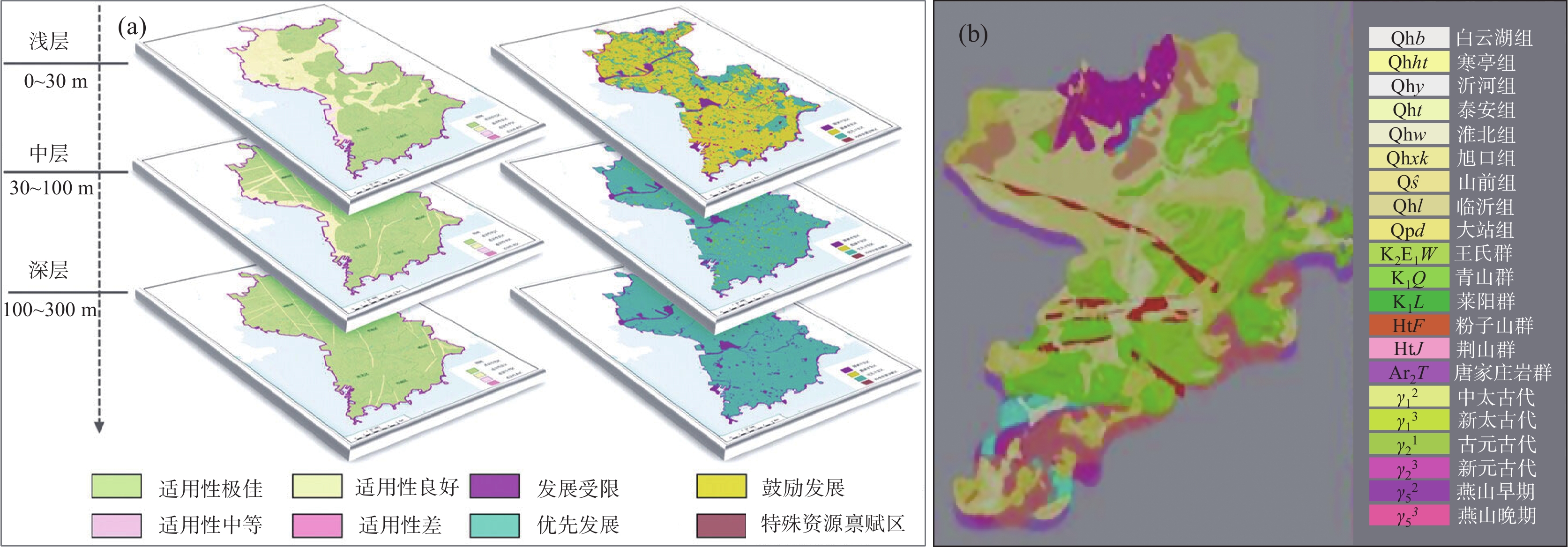The progress and prospects of underground space development and construction in Qingdao
-
摘要:
城市地下空间开发是解决“城市病”的重要途径,且开发不可逆转,需要总结经验,综合统筹开发。青岛市地下空间开发趋向成熟,但缺乏对开发现状的梳理、总结及研究,影响了地下空间的高效开发进程。文章厘清了青岛市地下空间发展历程,全面总结了地下空间各功能开发建设现状和研究进展,分析了青岛市地下空间开发的特点和存在的问题,提出青岛市地下空间开发一体化规划、建设和管理的重点,明确了城市高质量发展、资源与环境对地下空间开发的需求和支撑,指出了“透明青岛”的建设趋势。该研究对科学合理利用地下空间、推进青岛市地下城市建设具有重要意义。
Abstract:Urban underground space development is an important way to solve “urban diseases”. Since underground space development is irreversible, it is necessary to summarize experience for guiding the development of underground space in a comprehensive way. The development of underground space in Qingdao is going to reach maturity, but there lacks review and summary on the development status, hindering the efficient exploitation process. This paper systematically sorts out the development history of underground space in Qingdao and comprehensively summarizes the current situation and research progress of constructing each function in underground space. It also analyzes the characteristics and problems of underground space development in Qingdao and proposes suggestions for its integrated planning, construction and management. Finally, it clarifies the demand and support for underground space development in terms of high-quality urban development, resources and environment, and charts the path for constructing a “Transparent Qingdao”. This study is of great significance to scientifically and appropriately utilize underground space and to promote underground construction in Qingdao.
-

-
图 4 青岛市地下空间布局结构(据赵景伟等(2018)修改)
Figure 4.
图 5 青岛市竖向地下空间开发面积统计图(据夏伟强等(2019)修改)
Figure 5.
图 8 青岛市地下空间适宜性与可开发性分区图(a)和3D地质模型图(b)(Yu et al., 2023)
Figure 8.
表 1 青岛市地下空间开发利用阶段及特征
Table 1. Stages and characteristics of underground space development and utilization in Qingdao
发展阶段 时间/年 布局
形态功能类型 发展特征 初始阶段 1887—1949 散点
分布地下市政设施、军事防御设施 规模较小,功能单一 起步阶段 1949—1999 散点
分布地下市政设施、人防工程、过街通道 规模依旧较小,功能单一,不成体系 发展阶段 2000—2012 聚点
扩散地下停车场、地下商业、综合管廊 地下空间利用功能开始多样化,初现网格化布局 繁荣阶段 2013至今 网络
延伸轨道交通带动周边地下空间建设,功能多样化、人性化 形成以地铁站点及大型商业综合体开发为节点的地下空间开发体系 表 2 青岛市现行地下空间相关法规及规划统计表
Table 2. Current regulations and planning related to underground space in Qingdao
序号 类型 法规政策和规划 参考文献 1 综合法规 青岛市地下空间开发利用管理条例 (青岛市国防动员办公室, 2020) 2 专项法规-人防工程 青岛市人民防空工程建设管理办法(2022年修订)
青岛市人民防空法治建设实施意见(2021—2025年)(青岛市人民政府, 2022)
(青岛市人民防空办公室, 2021)3 专项法规-轨道交通 青岛市轨道交通条例 (青岛市交通运输局, 2021) 4 专项法规-市政管线 青岛市城市地下管线管理条例 (青岛市住房和城乡建设局, 2018) 5 专项法规-综合管廊 青岛市地下综合管廊规划建设管理办法(青政办发〔2021〕 7号)
关于加快地下综合管廊建设的实施意见(青政办发〔2016〕9号)(青岛市人民政府办公厅, 2021a)
(青岛市人民政府办公厅, 2016)6 专项法规-地下资源 青岛市地下空间国有建设用地使用权管理办法(青自然资规(规)字〔2020〕 1号) (青岛市自然资源和规划局, 2020) 7 总体规划 青岛城市地下空间资源综合利用总体规划(2014—2030年) (青岛市人民防空办公室和青岛市规划局, 2014)
8
专项规划青岛市中心城区地下空间开发利用专项规划(2021—2035年) (青岛市自然资源和规划局, 2023b) 青岛市城市更新专项规划(2021—2035年) (青岛市自然资源和规划局, 2023a) 青岛市城市轨道交通第三期建设规划(2021—2026年) (国家发展和改革委员会, 2021) -
[1] ADMIRAAL H, CORNARO A. 2016. Why underground space should be included in urban planning policy – And how this will enhance an urban underground future[J]. Tunnelling and Underground Space Technology,55:214-220. doi: 10.1016/j.tust.2015.11.013
[2] BESNER J. 2017. Cities think underground – underground space (also) for people[J]. Procedia Engineering,209:49-55. doi: 10.1016/j.proeng.2017.11.129
[3] BROERE W. 2016. Urban underground space: solving the problems of today’s cities[J]. Tunnelling and Underground Space Technology,55:245-248. doi: 10.1016/j.tust.2015.11.012
[4] CHEN X S, FU Y B, CHEN X, XIAO H, BAO X H, PANG X C, WANG X T. 2022. Progress in underground space construction technology and technical challenges of digital intelligence[J]. China Journal of Highway and Transport,35(1):1-12 (in Chinese with English abstract).
[5] CHEN X S, LI K, BAO X H, HONG C Y, FU Y B, CUI H Z. 2021. Innovations in the development of digital and intelligent construction of urban shield tunnels[J]. Journal of Basic Science and Engineering,29(5):1057-1074 (in Chinese with English abstract).
[6] CHENG G H, WANG R, ZHAO M H, SU J W, YANG Y, ZHANG X B. 2019. Present situation and developmental trend of urban underground space development and utilization in China[J]. Earth Science Frontiers,26(3):39-47 (in Chinese with English abstract).
[7] CUI J Q, BROERE W, LIN D. 2021. Underground space utilisation for urban renewal[J]. Tunnelling and Underground Space Technology,108:103726. doi: 10.1016/j.tust.2020.103726
[8] DENG Y R, WANG Y H, ZHAO Y J, GU P K, XIAO J, ZHOU J, LI Z H, YU Z Q, PENG P A. 2023. Carbon dioxide storage in China: current status, main challenges, and future outlooks[J]. Earth Science Frontiers,30(4):429-439 (in Chinese with English abstract).
[9] DONG Y H, PENG F L, ZHA B H, QIAO Y K, LI H. 2022. An intelligent layout planning model for underground space surrounding metro stations based on NSGA-II[J]. Tunnelling and Underground Space Technology,128:104648. doi: 10.1016/j.tust.2022.104648
[10] DOU Y G, YIN P, CHEN B, XUE B Y, WANG M L, ZOU L, HU R, XU G, YUE B J, SONG W Y, LIN X, DONG J, FU J N, XU R, HE S, LIN Q G. 2021. Application exploration, theoretical and technological innovation of geological survey results in coastal bedrock city: taking Qingdao as an example[J]. Marine Geology Frontiers,37(9):1-9 (in Chinese with English abstract).
[11] FU J N, LIU H H, DONG J, DOU Y G, MING Q, LIU H S, XIA W Q, ZOU L. 2021. Application of remote sensing technology to urban geological survey at Qingdao city[J]. Marine Geology Frontiers,37(9):69-78 (in Chinese with English abstract).
[12] GENERAL OFFICE OF QINGDAO MUNICIPAL GOVERNMENT. (2016-04-08)[2024-02-26]. Implementation opinions on accelerating the construction of comprehensive underground pipe corridors (General Office of Qingdao Municipal Government[2016] No. 9)[EB/OL]. http://www.qingdao.gov.cn/zwgk/zdgk/fgwj/zcwj/zfgb/2016_6_7/202010/t20201019_500528.shtml (in Chinese).
[13] GENERAL OFFICE OF QINGDAO MUNICIPAL GOVERNMENT. (2021a-04-01)[2024-02-26]. Qingdao underground comprehensive pipe corridor planning and construction management measures (General Office of Qingdao Municipal Government[2021] No. 7)[EB/OL]. http://www.qingdao.gov.cn/zwgk/xxgk/bgt/gkml/gwfg/202112/t20211213_3995078.shtml (in Chinese).
[14] GENERAL OFFICE OF QINGDAO MUNICIPAL GOVERNMENT. (2021b-11-29)[2024-02-26]. Qingdao "14th five-year plan" for the construction of emergency management system (General Office of Qingdao Municipal Government[2021] No. 81)[EB/OL]. http://www.qingdao.gov.cn/zwgk/xxgk/bgt/gkml/gwfg/202112/t20211213_3987914.shtml (in Chinese).
[15] GUO Z, QU Q F, FAN Z G, LIU G T, LU X F, GONG Y L. 2021. Construction technology innovation of double-shield tunnel boring machine in Qingdao metro line 1[J]. Tunnel Construction,41(8):1385-1391 (in Chinese with English abstract).
[16] HAN Z Y, WU S S, LIU Y M, HAN Z C, JIANG Y Y, GE C W, SONG W J. 2022. Calculation and evaluation of geothermal resources in northern Jinan geothermal field[J]. East China Geology,43(3):276-285 (in Chinese with English abstract).
[17] HAO M, WANG D H, DENG C, HE Z W, ZHANG J L, XUE D J, LING X M. 2019. 3D geological modeling and visualization of above-ground and underground integration—taking the Unicorn Island in Tianfu new area as an example[J]. Earth Science Informatics,12(4):465-474. doi: 10.1007/s12145-019-00394-z
[18] HE P, DONG J, GUAN Y, WANG Q, XIE Y J, LIU H S, YIN Z, FU J N. 2023. The well determination for geothermal resource exploration in typical islands in Xiaoguan Island, Qingdao[J]. Marine Geology Frontiers,39(8):38-48 (in Chinese with English abstract).
[19] LI Z Y, QIAO Y K, WU X L, PENG F L. 2022. Planning strategy for underground space development and utilization in urban redevelopment area[J]. Modern Tunnelling Technology,59(S1):143-151 (in Chinese with English abstract).
[20] LI Z Q, XUE Y G, QU L Q, SUN W H, LIU H L, ZHAO S S. (2023-07-26)[2024-04-23]. Primary unfavorable geology and construction risks of the second subsea tunnel of Jiaozhou bay in Qingdao city[J/OL]. Journal of Engineering Geology.doi: 10.13544/j.cnki.jeg.2022-0756 (in Chinese with English abstract).
[21] LIN D, BROERE W, CUI J Q. 2022. Underground space utilisation and new town development: experiences, lessons and implications[J]. Tunnelling and Underground Space Technology,119:104204. doi: 10.1016/j.tust.2021.104204
[22] LIU H H, WANG Z S, GENG L, ZHAO Y T, CHEN Y. 2024. Multilevel variable fuzzy variable weight comprehensive evaluation method for geological safety of urban underground space[J]. Journal of Safety and Environment,24(1):19-32 (in Chinese with English abstract).
[23] MA C X, PENG F L. 2018. Some aspects on the planning of complex underground roads for motor vehicles in Chinese cities[J]. Tunnelling and Underground Space Technology,82:592-612. doi: 10.1016/j.tust.2018.09.034
[24] NATIONAL DEVELOPMENT AND REFORM COMMISSION. (2009-08-31)[2024-02-26]. Recent construction plan for Qingdao urban rail transit (2009-2016)[EB/OL].https://zfxxgk.ndrc.gov.cn/web/iteminfo.jsp?id=4679 (in Chinese).
[25] NATIONAL DEVELOPMENT AND REFORM COMMISSION. (2013-12-11)[2024-02-26]. Recent construction plan for Qingdao urban rail transit (2013-2018)[EB/OL].https://www.ndrc.gov.cn/fggz/zcssfz/zdgc/201312/t20131211_1145897.html?state=123 (in Chinese).
[26] NATIONAL DEVELOPMENT AND REFORM COMMISSION. (2021-08-19)[2024-02-26]. Qingdao urban rail transit phase III construction plan (2021-2026)[EB/OL].https://www.ndrc.gov.cn/xxgk/zcfb/pifu/202109/t20210906_1316572.html (in Chinese).
[27] QIAN Q H. 2016. Present state, problems and development trends of urban underground space in China[J]. Tunnelling and Underground Space Technology,55:280-289. doi: 10.1016/j.tust.2015.11.007
[28] QIAN Q H. 2022. Energy geostructure engineering: promote carbon peak and neutrality, empower green cities[J]. Journal of Shenzhen University Science and Engineering,39(1):1-2 (in Chinese with English abstract). doi: 10.3724/SP.J.1249.2022.01001
[29] QINGDAO MUNICIPAL BUREAU OF HOUSING AND URBAN-RURAL DEVELOPMENT. (2018-03-15)[2024-02-26]. Qingdao urban underground pipeline management regulations[EB/OL]. http://sjw.qingdao.gov.cn/cxjsj24/cxjsj127/202112/t20211210_3972499.shtml (in Chinese).
[30] QINGDAO MUNICIPAL CIVIL AIR DEFENSE OFFICE. (2021-12-10)[2024-02-26]. Qingdao municipal civil air defense rule of law implementation opinions (2021-2025)[EB/OL]. http://qdrf.qingdao.gov.cn/renfb_zw/renfb_ml/ybj_gwfg/202112/t20211210_3982497.shtml (in Chinese).
[31] QINGDAO MUNICIPAL CIVIL AIR DEFENSE OFFICE, QINGDAO URBAN PLANNING BUREAU. (2014-11-28)[2024-02-26]. Qingdao urban underground space resources comprehensive utilization masterplan (2014-2030)[EB/OL]. http://qdrf.qingdao.gov.cn/renfb_zw/renfb_ml/ybj_gwfg/202010/t20201018_393288.shtml (in Chinese).
[32] QINGDAO MUNICIPAL GOVERNMENT. (2022-01-14)[2024-02-26]. Qingdao measures for the management of civil air defence project construction (Revised in 2022)[EB/OL]. http://www.qingdao.gov.cn/zwgk/zdgk/fgwj/fggz/zfgz/2022/202202/t20220225_4443775.shtml (in Chinese).
[33] QINGDAO MUNICIPAL NATURAL RESOURCES AND URBAN PLANNING BUREAU. (2020-01-22)[2024-02-26]. Measures for the administration of the right to use state-owned construction land in underground space in Qingdao (Qingdao Natural Resources Regulation[2020] No. 1)[EB/OL]. http://www.qingdao.gov.cn/zwgk/xxgk/zygh/gkml/gwfg/gfxwj/202312/t20231211_7709368.shtml (in Chinese).
[34] QINGDAO MUNICIPAL NATURAL RESOURCES AND URBAN PLANNING BUREAU. (2023a-03-10)[2024-02-26]. Qingdao urban renewal special plan (2021-2035)[EB/OL]. http://zrzygh.qingdao.gov.cn/zxfw/zrzyghggzyxx/ghgl/ghcajpzjg/zxgh/202303/t20230310_7043945.shtml (in Chinese).
[35] QINGDAO MUNICIPAL NATURAL RESOURCES AND URBAN PLANNING BUREAU. (2023b-06-08)[2024-02-26]. Special plan for the development and utilization of underground space in Qingdao city Centre (2021-2035)[EB/OL]. http://zrzygh.qingdao.gov.cn/gzdt/xtyw/202306/t20230608_7219818.shtml (in Chinese).
[36] QINGDAO MUNICIPAL NATURAL RESOURCES AND URBAN PLANNING BUREAU. (2021-07-27)[2024-02-26]. Territorial spatial planning of Qingdao city (2021-2035)[EB/OL]. http://zrzygh.qingdao.gov.cn/zxfw/zrzyghggzyxx/ghgl/ghcajpzjg/csztgh/202204/t20220402_5165591.shtml (in Chinese).
[37] QINGDAO MUNICIPAL TRANSPORT BUREAU. (2021-10-19)[2024-02-26]. Qingdao railway traffic regulations[EB/OL]. http://qdjt.qingdao.gov.cn/jtj_zcfg/sjjbmzcfg_54/202112/t20211214_3998988.shtml (in Chinese).
[38] QINGDAO NATIONAL DEFENSE MOBILIZATION OFFICE. (2020-07-06)[2024-02-26]. Qingdao underground space development and utilisation regulations[EB/OL]. http://qdrf.qingdao.gov.cn/renfb_zc/renfb_flfg/202205/t20220509_6041673.shtml (in Chinese).
[39] SHAO F, SHI P Y, DING Y S, DONG C. 2021. The integrated development strategy of coastal industrial areas and city based on underground space development[J]. Geofluids,2021:4336163. doi: 10.1155/2021/4336163
[40] SHAO F, WANG Y S. 2022. Intelligent overall planning model of underground space based on digital twin[J]. Computers and Electrical Engineering,104:108393. doi: 10.1016/j.compeleceng.2022.108393
[41] VÄHÄAHO I. 2016. An introduction to the development for urban underground space in Helsinki[J]. Tunnelling and Underground Space Technology,55:324-328. doi: 10.1016/j.tust.2015.10.001
[42] VON DER TANN L, STERLING R, ZHOU Y X, METJE N. 2020. Systems approaches to urban underground space planning and management – a review[J]. Underground Space,5(2):144-166. doi: 10.1016/j.undsp.2019.03.003
[43] WANG S H, YANG X, JIANG Y S, LIU Q W, ZHAO J Z, ZHU Z J, SHAO C Z, TAN Z L, YANG Z Y. 2023. Synchronous backfilling technology for gravel and bottom grouting behind double-shield tunnel boring machine segment: a case study of a section of Qingdao Metro Line 6[J]. Tunnel Construction,43(11):1954-1963 (in Chinese with English abstract).
[44] XIA W Q, DONG J, HE P, XIE Y J. 2019. Evaluation and suitability zoning of geological factors affecting the development and utilization of underground space in the main urban area of Qingdao[J]. Acta Geologica Sinica,93(S1):233-240 (in Chinese with English abstract).
[45] XU Y J, CHEN X S. 2023. Current situation and prospect of comprehensive development of underground space in metro area[J]. Chinese Journal of Underground Space and Engineering,19(1):1-12,21 (in Chinese with English abstract).
[46] XU M J, LIU H H, YANG B K, DONG J, HE P, ZOU L, HU R, LENG Q. 2021. Key technology and its application to evaluation of carrying capacity of geo-resources and geo-environment in Qingdao[J]. Marine Geology Frontiers,37(9):79-88 (in Chinese with English abstract).
[47] XUE Y G, LI S C, SU M X, ZHANG X, ZHAO Y, LI W T. 2009. Practice of comprehensive early-warning geological prediction on aquifer fault in Qingdao Kiaochow bay subsea tunnel[J]. Chinese Journal of Rock Mechanics and Engineering,28(10):2081-2087 (in Chinese with English abstract).
[48] YANG P J, PENG S, WANG J, WANG Q, REN N, SONG W N. 2024. Carbon Capture, Utilization and Storage (CCUS) technology development status and application prospects[J]. China Environmental Science,44(1):404-416 (in Chinese with English abstract).
[49] YANG Y, WANG R, ZHAO M H, XING H X, ZHENG H J, ZHANG Q, CHEN C X, LI Y F, CHENG G H. 2022. Study on exploration and evaluation technology system of urban underground space resources[J]. East China Geology,43(2):245-254 (in Chinese with English abstract).
[50] YU P, LIU H H, WANG Z S, FU J N, ZHANG H, WANG J, YANG Q. 2023. Development of urban underground space in coastal cities in China: a review[J]. Deep Underground Science and Engineering,2(2):148-172. doi: 10.1002/dug2.12034
[51] YU Y H, YAN B. 2021. Present situation and development trend of underground space in megacity in China[J]. Chinese Journal of Underground Space and Engineering,17(S1):1-7 (in Chinese with English abstract).
[52] ZACHARIAS J, HE J. 2018. Hong Kong’s urban planning experiment in enhancing pedestrian movement from underground space to the surface[J]. Tunnelling and Underground Space Technology,82:1-8. doi: 10.1016/j.tust.2018.07.025
[53] ZHANG S P, LIU X L, CHENG G W, ZHU C Q, LI Q P, HE Y F. 2023. Geoenvironmental hazard risks and monitoring technologies for marine carbon sequestration[J]. Strategic Study of CAE,25(3):122-130 (in Chinese with English abstract). doi: 10.15302/J-SSCAE-2023.03.011
[54] ZHAO Y T, LIU H H, QU W L, LUAN P Y, SUN J. 2023. Research on geological safety evaluation index systems and methods for assessing underground space in coastal bedrock cities based on a Back-Propagation Neural Network Comprehensive Evaluation–Analytic Hierarchy Process (BPCE-AHP)[J]. Sustainability,15(10):8055. doi: 10.3390/su15108055
[55] ZHAO J W, LV Z Z, PANG S C, LU X T, PENG F L. 2015. Development control on underground space of ecoparks in the multifunctional city-taking Qingdao Sino-German Ecopark for example[J]. Chinese Journal of Underground Space and Engineering,11(4):826-833 (in Chinese with English abstract).
[56] ZHAO J W, PENG F L, WANG T Q, ZHANG X Y, JIANG B N. 2016. Advances in master planning of urban underground space (UUS) in China[J]. Tunnelling and Underground Space Technology,55:290-307. doi: 10.1016/j.tust.2015.11.011
[57] ZHAO J W, WANG T L, ZHANG X W, PENG F L. 2018. “1X35” Framework-Based overall planning of urban underground space: a case study of underground space of the west coast new district of Qingdao[J]. Modern Urban Research,(8):59-68 (in Chinese with English abstract).
[58] ZHU Y, WANG M L, XUE B Y, ZOU L, DOU Y G. 2023. Geological environment issues and spatial planning countermeasures in the coastal zone of Qingdao City[J]. Marine Geology Frontiers,39(8):1-7 (in Chinese with English abstract).
[59] ZOU L, DOU Y G, HU R, LIN X, WANG R L. 2021. Land quality evaluation and development planning for the Guzhenkou innovation and development demonstration region of Qingdao[J]. Marine Geology Frontiers,37(9):49-59 (in Chinese with English abstract).
[60] 陈湘生, 付艳斌, 陈曦, 肖惠, 包小华, 庞小朝, 王雪涛. 2022. 地下空间施工技术进展及数智化技术现状[J]. 中国公路学报,35(1):1-12. doi: 10.3969/j.issn.1001-7372.2022.01.001
[61] 陈湘生, 李克, 包小华, 洪成雨, 付艳斌, 崔宏志. 2021. 城市盾构隧道数字化智能建造发展概述[J]. 应用基础与工程科学学报,29(5):1057-1074.
[62] 程光华, 王睿, 赵牧华, 苏晶文, 杨洋, 张晓波. 2019. 国内城市地下空间开发利用现状与发展趋势[J]. 地学前缘,26(3):39-47.
[63] 邓一荣, 汪永红, 赵岩杰, 谷培科, 肖瑾, 周健, 李朝晖, 于志强, 彭平安. 2023. 碳中和背景下二氧化碳封存研究进展与展望[J]. 地学前缘,30(4):429-439.
[64] 窦衍光, 印萍, 陈斌, 薛碧颖, 王蜜蕾, 邹亮, 胡睿, 徐刚, 岳保静, 宋维宇, 林曦, 董杰, 付佳妮, 徐锐, 何松, 林琴岗. 2021. 滨海基岩城市地质调查成果应用探索与理论技术创新——以青岛市为例[J]. 海洋地质前沿,37(9):1-9.
[65] 付佳妮, 刘洪华, 董杰, 窦衍光, 明强, 刘海松, 夏伟强, 邹亮. 2021. 遥感技术在青岛市城市地质调查中的应用[J]. 海洋地质前沿,37(9):69-78.
[66] 国家发展和改革委员会. (2009-08-31)[2024-02-26]. 青岛市城市轨道交通近期建设规划(2009—2016年)[EB/OL].https://zfxxgk.ndrc.gov.cn/web/iteminfo.jsp?id=4679.
[67] 国家发展和改革委员会. (2013-12-11)[2024-02-26]. 青岛市城市轨道交通近期建设规划(2013—2018)[EB/OL].https://www.ndrc.gov.cn/fggz/zcssfz/zdgc/201312/t20131211_1145897.html?state=123.
[68] 国家发展和改革委员会. (2021-08-19)[2024-02-26]. 青岛市城市轨道交通第三期建设规划(2021—2026年)[EB/OL].https://www.ndrc.gov.cn/xxgk/zcfb/pifu/202109/t20210906_1316572.html.
[69] 郭志, 曲秋芬, 樊治国, 刘桂涛, 路效峰, 宫迎雷. 2021. 青岛地铁1号线双护盾TBM施工技术创新[J]. 隧道建设(中英文),41(8):1385-1391.
[70] 韩中阳, 吴沙沙, 刘咏明, 韩子晨, 姜彦玉, 戈成旺, 宋文静. 2022. 济南市北部地热田地热资源量计算与评价[J]. 华东地质,43(3):276-285.
[71] 何鹏, 董杰, 管勇, 王青, 解永健, 刘海松, 尹政, 付佳妮. 2023. 典型海岛地热资源勘查定井方法研究——以青岛市小管岛为例[J]. 海洋地质前沿,39(8):38-48.
[72] 李子玉, 乔永康, 吴晓雷, 彭芳乐. 2022. 城市更新地区地下空间开发利用规划策略研究[J]. 现代隧道技术,59(S1):143-151.
[73] 李志强, 薛翊国, 曲立清, 孙文昊, 刘洪亮, 赵世森.(2023-07-26)[2024-04-23]. 青岛胶州湾第二海底隧道主要不良地质与施工风险分析[J/OL]. 工程地质学报.doi: 10.13544/j.cnki.jeg.2022-0756.
[74] 刘洪华, 王忠胜, 耿林, 赵玉婷, 陈闫. 2024. 城市地下空间地质安全多级变模糊变权综合评价法[J]. 安全与环境学报,24(1):19-32.
[75] 钱七虎. 2022. 能源地下结构与工程—助力“双碳”目标, 赋能绿色城市[J]. 深圳大学学报(理工版),39(1):1-2.
[76] 青岛市国防动员办公室. (2020-07-06)[2024-02-26]. 青岛市地下空间开发利用管理条例[EB/OL]. http://qdrf.qingdao.gov.cn/renfb_zc/renfb_flfg/202205/t20220509_6041673.shtml.
[77] 青岛市交通运输局. (2021-10-19)[2024-02-26]. 青岛市轨道交通条例[EB/OL]. http://qdjt.qingdao.gov.cn/jtj_zcfg/sjjbmzcfg_54/202112/t20211214_3998988.shtml.
[78] 青岛市人民防空办公室. (2021-12-10)[2024-02-26]. 青岛市人民防空法治建设实施意见(2021—2025年)[EB/OL]. http://qdrf.qingdao.gov.cn/renfb_zw/renfb_ml/ybj_gwfg/202112/t20211210_3982497.shtml.
[79] 青岛市人民防空办公室, 青岛市规划局. (2014-11-28)[2024-02-26]. 青岛城市地下空间资源综合利用总体规划(2014—2030年)[EB/OL]. http://qdrf.qingdao.gov.cn/renfb_zw/renfb_ml/ybj_gwfg/202010/t20201018_393288.shtml.
[80] 青岛市人民政府. (2022-01-14)[2024-02-26]. 青岛市人民防空工程建设管理办法(2022年修订)[EB/OL]. http://www.qingdao.gov.cn/zwgk/zdgk/fgwj/fggz/zfgz/2022/202202/t20220225_4443775.shtml.
[81] 青岛市人民政府办公厅. (2016-04-08)[2024-02-26]. 关于加快地下综合管廊建设的实施意见(青政办发〔2016〕9号)[EB/OL]. http://www.qingdao.gov.cn/zwgk/zdgk/fgwj/zcwj/zfgb/2016_6_7/202010/t20201019_500528.shtml.
[82] 青岛市人民政府办公厅. (2021a-04-01)[2024-02-26]. 青岛市地下综合管廊规划建设管理办法(青政办发〔2021〕7号)[EB/OL]. http://www.qingdao.gov.cn/zwgk/xxgk/bgt/gkml/gwfg/202112/t20211213_3995078.shtml.
[83] 青岛市人民政府办公厅. (2021b-11-29)[2024-02-26]. 青岛市“十四五”应急管理体系建设规划(青政办字〔2021〕81号)[EB/OL]. http://www.qingdao.gov.cn/zwgk/xxgk/bgt/gkml/gwfg/202112/t20211213_3987914.shtml.
[84] 青岛市住房和城乡建设局. (2018-03-15)[2024-02-26]. 青岛市城市地下管线管理条例[EB/OL]. http://sjw.qingdao.gov.cn/cxjsj24/cxjsj127/202112/t20211210_3972499.shtml.
[85] 青岛市自然资源和规划局. (2020-01-22)[2024-02-26]. 青岛市地下空间国有建设用地使用权管理办法(青自然资规(规)字〔2020〕1号)[EB/OL]. http://www.qingdao.gov.cn/zwgk/xxgk/zygh/gkml/gwfg/gfxwj/202312/t20231211_7709368.shtml.
[86] 青岛市自然资源和规划局. (2021-07-27)[2024-02-26]. 青岛市国土空间总体规划(2021—2035年)(草案)[EB/OL]. http://zrzygh.qingdao.gov.cn/zxfw/zrzyghggzyxx/ghgl/ghcajpzjg/csztgh/202204/t20220402_5165591.shtml.
[87] 青岛市自然资源和规划局. (2023a-03-10)[2024-02-26]. 青岛市城市更新专项规划(2021—2035年)[EB/OL]. http://zrzygh.qingdao.gov.cn/zxfw/zrzyghggzyxx/ghgl/ghcajpzjg/zxgh/202303/t20230310_7043945.shtml.
[88] 青岛市自然资源和规划局. (2023b-06-08)[2024-02-26]. 青岛市中心城区地下空间开发利用专项规划(2021—2035年)[EB/OL]. http://zrzygh.qingdao.gov.cn/gzdt/xtyw/202306/t20230608_7219818.shtml.
[89] 王守慧, 杨星, 江玉生, 刘泉维, 赵继增, 朱志敬, 邵长志, 谭卓林, 杨志勇. 2023. 双护盾TBM管片壁后豆砾石与底部灌浆同步回填技术研究——以青岛地铁6号线某工程为例[J]. 隧道建设(中英文),43(11):1954-1963.
[90] 夏伟强, 董杰, 何鹏, 解永健. 2019. 青岛主城区地下空间开发利用地质因素的影响评价及适宜性分区[J]. 地质学报,93(S1):233-240.
[91] 徐雅洁, 陈湘生. 2023. 地铁域地下空间综合开发研究现状与展望[J]. 地下空间与工程学报,19(1):1-12,21.
[92] 徐美君, 刘洪华, 杨宝凯, 董杰, 何鹏, 邹亮, 胡睿, 冷琦. 2021. 青岛市地质资源环境承载能力评价关键技术与应用[J]. 海洋地质前沿,37(9):79-88.
[93] 薛翊国, 李术才, 苏茂鑫, 张霄, 赵岩, 李为腾. 2009. 青岛胶州湾海底隧道含水断层综合超前预报实践[J]. 岩石力学与工程学报,28(10):2081-2087. doi: 10.3321/j.issn:1000-6915.2009.10.016
[94] 阳平坚, 彭栓, 王静, 王强, 任妮, 宋维宁. 2024. 碳捕集、利用和封存(CCUS)技术发展现状及应用展望[J]. 中国环境科学,44(1):404-416.
[95] 杨洋, 王睿, 赵牧华, 邢怀学, 郑红军, 张庆, 陈春霞, 李云峰, 程光华. 2022. 城市地下空间资源探测评价技术体系研究[J]. 华东地质,43(2):245-254.
[96] 余苑航, 阎波. 2021. 我国超大城市地下空间开发现状及其发展趋势[J]. 地下空间与工程学报,17(S1):1-7.
[97] 张少鹏, 刘晓磊, 程光伟, 朱超祁, 李清平, 何玉发. 2023. 海底碳封存环境地质灾害风险及监测技术研究[J]. 中国工程科学,25(3):122-130.
[98] 赵景伟, 吕占志, 逄淑超, 鲁晓婷, 彭芳乐. 2015. 功能复合型城市生态园地下空间开发控制—以青岛中德生态园为例[J]. 地下空间与工程学报,11(4):826-833.
[99] 赵景伟, 王太亮, 张晓玮, 彭芳乐. 2018. 基于“1X35”框架的城市地下空间总体规划编制研究—以青岛西海岸新区地下空间为例[J]. 现代城市研究,(8):59-68. doi: 10.3969/j.issn.1009-6000.2018.08.009
[100] 朱妍, 王蜜蕾, 薛碧颖, 邹亮, 窦衍光. 2023. 青岛市海岸带地质环境问题与空间规划对策建议[J]. 海洋地质前沿,39(8):1-7.
[101] 邹亮, 窦衍光, 胡睿, 林曦, 王瑞龙. 2021. 青岛古镇口创新示范区土地质量评价及规划利用[J]. 海洋地质前沿,37(9):49-59.
-




 下载:
下载:

